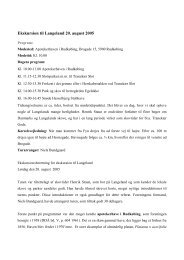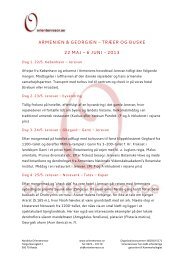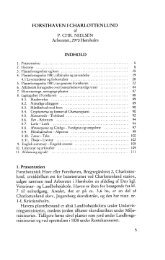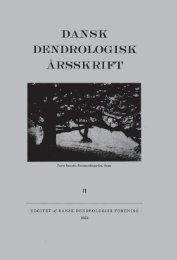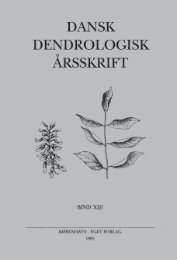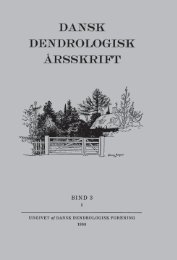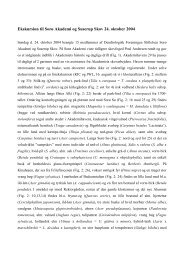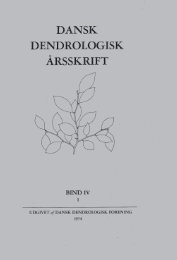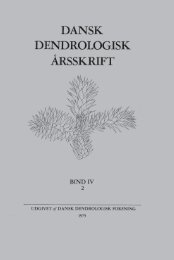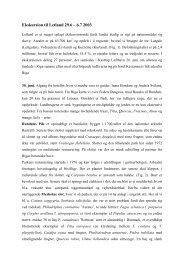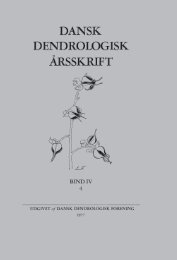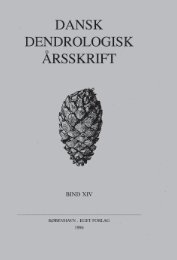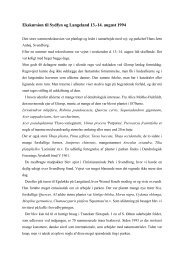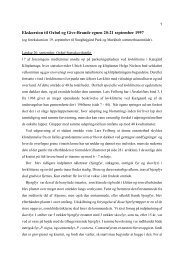Volume 2,1 (1963) - Dansk Dendrologisk Forening
Volume 2,1 (1963) - Dansk Dendrologisk Forening
Volume 2,1 (1963) - Dansk Dendrologisk Forening
You also want an ePaper? Increase the reach of your titles
YUMPU automatically turns print PDFs into web optimized ePapers that Google loves.
so slender as in the former variety and their surface is dull and often<br />
covered with scales of dried up resin. The resin has besides more or<br />
less of the perfume-odour a pronounced sharp touch of terpeneodour.<br />
The cones vary in size and show a more regular production<br />
with intervals of a few years. Phaeocryptopus and the Chermes maybe<br />
common but do not seem to be so grave for it perhaps due to more<br />
pronounced frostresistance in caesia. Nor is Rhabdocline of any importance.<br />
It is found from the coast to the most dry interior growingplaces<br />
for Pseudotsuga-, in southern Oregon the viridis has quite disappeared<br />
even near the shores of the Pacific thus giving place to pure<br />
stands of caesia types. Just the same could be seen in the dry interior<br />
zone of British Columbia, where caesia was dominant all over, and<br />
often nearly blue with characters very close to those of the following<br />
variety. Every time mountains brought about moister conditions and<br />
spots of better sites viridis types occured in considerable number.<br />
This may also be the case in the fog-zone in southern Oregon and<br />
North California but I do not know anything about it, I have not<br />
been there myself and the Americans do not distinguish between<br />
caesia and glauca.<br />
Var. glauca has rather short and stiff needles on very distinct pulvini.<br />
The needles are very bluish and often with a shallow emargination<br />
at the apex. They are completely without any parting on the twigs.<br />
Winterbuds not so dark and not so resinous as in caesia. The resin<br />
has a pure and rather sharp smell of terpentine. The cones are small<br />
with extraordinary long bracts and produced abundantly nearly<br />
every year. I have no information about Phaeocryptopus and Adelges<br />
of this but the little I have seen (most glaucas die young here in Denmark<br />
on account of severe attacks of Rhabdocline) have left an impression<br />
that they are of no importance to it. Glauca is confined to<br />
Colorado where it represents the southeastern outposts of the<br />
Douglas-Fir.<br />
We cannot divide Pseudotsuga Menziesii into three species, they<br />
are all too closely allied. As far as I know they are quite interfertile<br />
and not too sharply parted into ecological units, but the occurence and<br />
characters of the blue Douglas may allow us to call it an ecospecies.<br />
2. Pinus contorta Loud, and Pinus contorta latifolia S. Wats.<br />
(P. Murrayana Balf.) have always been problematic for the Danish<br />
foresters and so they are to the Americans too, foresters as well as<br />
botanists. After having looked at them myself I find it very illustrating<br />
to compare them to Common Mountain Pine (P. Mugo rotundata)<br />
and Pyrenean Mountain Pine (P. Mugo rostrata).<br />
6*



